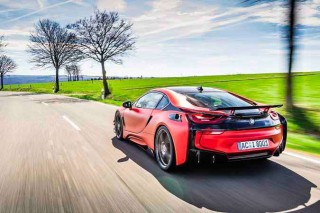BMW’S i8 has gained many fans since its launch back in 2014, and while it’s not perfect, it has a broad range and depth of talents. Motorway cruiser, back-road blaster – it’s equally accomplished at either task. And when you consider this is BMW’s first stab at a hybrid performance car, it’s hard not to be impressed. But there is still room for improvement, not least at the car’s front end, where you’ll find slightly lacklustre steering and a tendency to understeer thanks to its narrow, eco-friendly tyres.

While M235i drivers have a plethora of tuning companies they can turn to for upgrades, if you own an i8, AC Schnitzer is just about the only respected outfit that can help. Its offerings for the petrol-electric coupe can be applied individually, but together they create a model called the ACS8, and as you’ve probably already noticed, many of the changes are cosmetic.
The i8’s futuristic styling – the roots of which go back to the BMW Vision Efficient Dynamics show car of 2009 – may still look fresh and innovative, but some will always want to personalise things. To this end there’s an ‘Inferno Red Chrome’ wrap to address the limitations of BMW’s rather dull standard colour palette, plus a slathering of carbonfibre accessories.
In fact there’s carbonfibre pretty much everywhere you look: the three-piece front spoiler, the bonnet vent, the mirror caps, the sills, the three-part rear diffuser, the door-handle panels – and there’s no missing that wing on the rear deck. There are even carbonfibre air vents that have been added behind the front wheels and on top of the rear wings. While the former have a nigh-on factory appearance, we’re less convinced by the latter.
Overall Schnitzer’s additions do complement the car’s appearance, although the rear spoiler is a little incongruous given the rest of the addons are integrated with the car’s flamboyant shape. The choice is up to you, though – if you don’t like it, leave it off.

Beyond all of this decoration are other modifications that actually impact the way the car drives. There’s no power upgrade as yet – Schnitzer is exploring this possibility, but given the way that the three-cylinder engine and electric motor are so seamlessly integrated, it’s proving remarkably tricky. What we do have here, though, are suspension, wheel and tyre changes.
A spring kit lowers the car by 25mm at the front and 20mm at the rear, endowing it with a lower centre of gravity. Schnitzer has also fitted a set of its AC1 forged alloy wheels. These are lighter than BMW’s standard 20- inch ‘Turbine’ items – by 4.4kg overall – despite being an inch wider and an inch larger in diameter. There’s grippier rubber on offer, too, and the 245/35 front and 285/30 rear Michelin Pilot Super Sports are appreciably wider than both the standard (195/50 and 215/45) and optional (215/45 and 245/40s) i8 Bridgestone rubber. By the time the wider tyres have been fitted, the weight of the Schnitzer wheel and tyre combination is the same as the standard car’s, but to get that much extra rubber on the road without a weight penalty is a good effort.
These are seemingly small changes perhaps, but do they fundamentally alter the car? When cruising along you’d be hard pressed to tell it’s sitting on different springs or that the wheels are an inch bigger, as the ride is still pliant and composed. But let the i8 off the leash and throw some decent corners into the mix and the ACS8 feels more alive than the standard car.
The extra rubber at the front end adds a little weight to the steering and as you start pushing harder there’s significant additional bite, with much less of a tendency for understeer. With appreciably more grip from the rear wheels, too, and still with the standard 228bhp three-cylinder engine driving them, it’s very hard to unstick the back end, but as it struggles less for traction the ACS8 can still slingshot you out of corners in an immensely satisfying fashion. The lowered ride height plays its part, the uprated springs giving the car a pretty flat cornering attitude without upsetting the original’s ride or balance. As a way of increasing your i8’s cornering performance without giving it any more horsepower, it’s very effective.

The upgrades don’t come cheap, though, and if you wanted your BMW i8 to look like this one, AC Schnitzer UK will carry out a complete conversion for £34,995 – which doesn’t include the wrap. Priced individually the majority of the larger carbonfibre parts cost over £3000 each, and even if you just want the springs plus the wheel and tyre set-up you’ll be spending nigh-on £10,000.
Expensive perhaps, especially when added to an i8’s £106k on-the-road price, but with used i8s starting at about £60,000, we can see why you might be tempted…
Above: carbonfibre vents on the rear haunches don’t gel like those at the front. Opposite page, bottom: carbonfibre rear wing also looks a little out of place, so won’t be to all tastes.
‘It adopts a flat cornering attitude without upsetting the original’s ride or balance’
TECHNICAL DATA FILE SPECIFICATION 2018 AC Schnitzer ACS8
Engine In-line 3-cyl, 1499cc, plus 96kW electric motor
Power 357bhp @ 5800rpm / DIN
Torque 420lb ft @ 3700rpm / DIN
0-62mph 4.4sec (claimed)
Top speed 155mph (limited)
Weight 1485kg (244bhp/ton)
Price See text
+ Genuine dynamic improvements
– Price, gawky rear spoiler
Drive-My rating 4+





